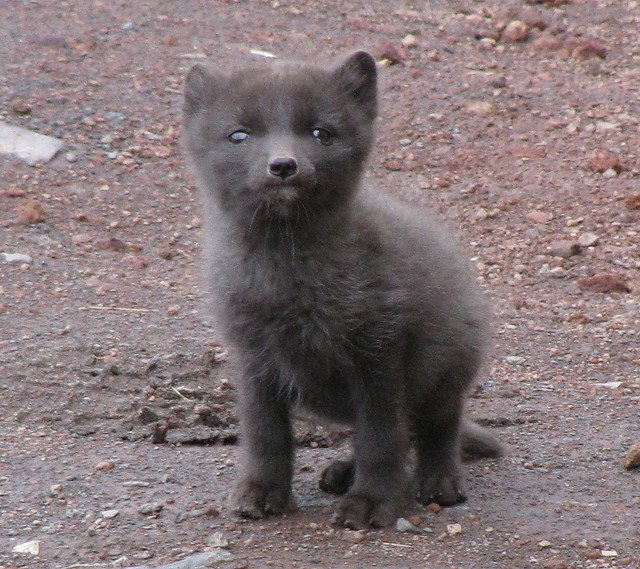Reproduction
Find this picture on Flickr here.
 Reproduction is an ever critical part of
survival. The artic fox will tend to have several
factors influencing its reproduction, such as mate availability,
weather, and others with the main factor being availability of
food. The arctic fox is an
opportunist carnivore, meaning that it will tend to take
advantages of what food it has in its environment at a given
time.
Alopex lagopus has two types of feeding strategies that it will
employ based on its environment and the conditions involved. A generalist
strategy of having a weak preference in prey choice will be used
when a lot of various food sources are available to the animal,
while a specialist strategy with a strong prey choice is found
in areas with less food opportunities.
The specialist strategy can often restrict the diet of the
animal, while a generalist will move on if a food source is
declining. The diet of the
arctic fox will vary depending on where it lives. If it lives near a coast it
will have a much greater variety in its diet, while the foxes
living on the inland will have much greater restrictions on
their diet in times of low rodent density, and therefore more of
an impact on number of litters.
The artic fox has a diet that consists mainly of lemmings
(Elmhagen, et al 2000).
Fox density will tend greatly to be based on the density of the
vole and lemming populations. This means that the fox’s primary food source will
impact trends in how they mate. “The importance of rodents is exemplified by
the correlation between the number of artic foxes and number of
lemmings” (Angerbjorn, et al 1991). The number of occupied dens is greatly dependent on
the amount of food in the habitat (Elmhagen, et al 2000;
Angerbjorn, et al 1991).
When there is a high abundance of food, den occupation is higher
with more reproduction attempts and therefore a higher number of
litters produced.
Reproduction varies greatly depending on the environment, with
population trends occurring on average every four years. Food availability can play a large role in
this trend, as well as sibling competition, occasional
siblicide, and rarely parent abandonment (Angerbjorn, et al
1991).
Reproduction is an ever critical part of
survival. The artic fox will tend to have several
factors influencing its reproduction, such as mate availability,
weather, and others with the main factor being availability of
food. The arctic fox is an
opportunist carnivore, meaning that it will tend to take
advantages of what food it has in its environment at a given
time.
Alopex lagopus has two types of feeding strategies that it will
employ based on its environment and the conditions involved. A generalist
strategy of having a weak preference in prey choice will be used
when a lot of various food sources are available to the animal,
while a specialist strategy with a strong prey choice is found
in areas with less food opportunities.
The specialist strategy can often restrict the diet of the
animal, while a generalist will move on if a food source is
declining. The diet of the
arctic fox will vary depending on where it lives. If it lives near a coast it
will have a much greater variety in its diet, while the foxes
living on the inland will have much greater restrictions on
their diet in times of low rodent density, and therefore more of
an impact on number of litters.
The artic fox has a diet that consists mainly of lemmings
(Elmhagen, et al 2000).
Fox density will tend greatly to be based on the density of the
vole and lemming populations. This means that the fox’s primary food source will
impact trends in how they mate. “The importance of rodents is exemplified by
the correlation between the number of artic foxes and number of
lemmings” (Angerbjorn, et al 1991). The number of occupied dens is greatly dependent on
the amount of food in the habitat (Elmhagen, et al 2000;
Angerbjorn, et al 1991).
When there is a high abundance of food, den occupation is higher
with more reproduction attempts and therefore a higher number of
litters produced.
Reproduction varies greatly depending on the environment, with
population trends occurring on average every four years. Food availability can play a large role in
this trend, as well as sibling competition, occasional
siblicide, and rarely parent abandonment (Angerbjorn, et al
1991).
Alopex lagopus
reproduces sexually.
Parents will tend to be monogamous and may have a non-breeding female living
in the den to help with the pups (Cameron, et al 2011).